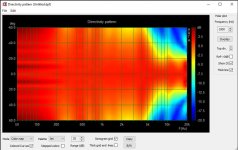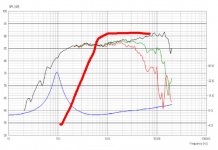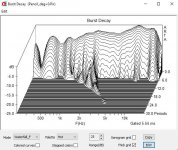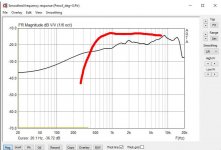I've been doing a lot of testing myself on improving the directivity and I think a solution can be found in a front horn design that reduces the throat size. Here's a Scanspeak 10F comparison between horn and non-horn configurations. There radiating diameter of the 10F is 76mm. This horn throat is a vertical slot that's 45mm wide x 76mm tall. The horn loads the driver down to 250Hz. I suspect a horn with a 1kHz cuttoff might perform better for upper treble performance in off-axis.
Attachments
Which 10F, Joseph?
dave
I was using the Thiel version of the 10F/8424G. I see the Thiel version is no longer available from Madisound (8424G-02) which had a truncated frame for closer driver spacing.
A very close equivalent would be here...
Scanspeak Discovery 10F/8424G 4" Midrange 8 ohm
The driver has very little breakup in the upper treble. Right now I'm thinking of doing a shallow front horn with a 600Hz Fc which should sum flat with the driver's natural rising response. It would be a nice pairing with something like the Fostex FW208HS which I'm also really liking for small room listening.
Shown below is my prediction on the response in a front horn. Also my own burst decay measurements in ARTA for the Thiel 10F/8424-G02 showing subtle breakup at 19kHz (very good!).
Attachments
Last edited:
This is my own measurement of the 8424G-02 on a narrow baffle. Again the response looks ideal for horn loading. The burst decay plots look better than most compression drivers short of something that's beryllium. Maybe it's the fibreglass cone/dust cap that's very effective here I'm not sure. I certainly like the sound as well. Very lively similar to Fostex but without the aggressiveness, and not overly damped like some other drivers I've tested.
Attachments
I agree that the 10F/8424 is the smoothest full range driver there is. It plays all genre's well.
10F/8424 & RS225-8 FAST / WAW Ref Monitor
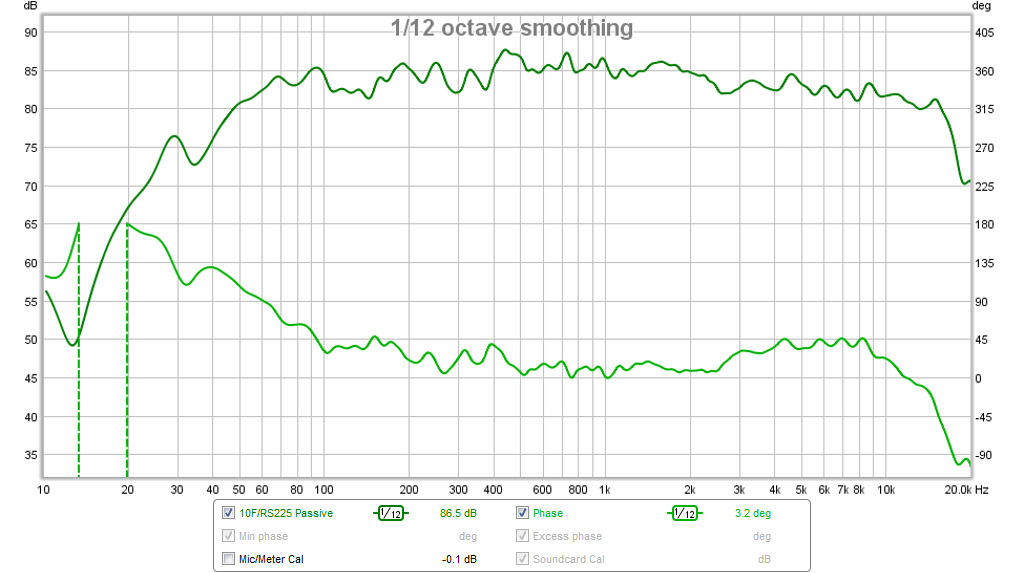
10F/8424 & RS225-8 FAST / WAW Ref Monitor

Diffuser
A full range which is designed to have a diffuser helps a lot because you can use different diffusers to even the power response which also helps to flatten the on axis frequency response.
A full range which is designed to have a diffuser helps a lot because you can use different diffusers to even the power response which also helps to flatten the on axis frequency response.
What exactly do you mean by “diffuser” and what drivers are designed specifically with one in mind?
I would agree that the 10F/8424 is the smoothest full range that I've used. With some bass support it really is excellent.
What exactly do you mean by “diffuser” and what drivers are designed specifically with one in mind?
Here is a really good website which shows different diffusers, most of them homemade, being installed in front of a Lowther driver, and how it affects the power/frequency response.
Audioprogress
Clearly the conical and exponential phase plugs dramatically effect the high frequency response - it does so by reducing the beaming of high frequencies from the whizzer cone.
This webpage shows the mushroom diffuser used with the Beauhorn Virtuoso speakers.
Gallery – BeauHorn.com
Retsel
... different diffusers
More typically called phase plugs (althou they aren’t really). I have found that every whizzer cone driver i have had benefits, some without (PP transform the Viston B200) also benefit.
They are not without issues and some drivers do not benefit fro them.
dave
smoothest fullrange driver through the sibilance range?
the JVC oblique cone
proof:
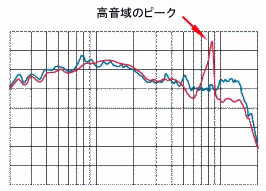
it's physics
the JVC oblique cone
proof:

it's physics
I just came across this article when looking for information on low power amplifiers. Hope it is useful to this discussion:
http://www.firstwatt.com/pdf/art_cs_amps.pdf
http://www.firstwatt.com/pdf/art_cs_amps.pdf
Sibilance has been my problem no.1 too. I got very good progress ditching 6.5 inch mid and replacing it with three PC83-8 fullranges connected in series. For some reason I cannot get them play anything above 6300 hz(measurement verifies this). Accidentally they almost fit with AMT-pro ribbons cut about over 7000hz. Those ribbons had no use before but they are great when cut very high. About sibilance I suspect becasue ss are made of noise like sound they could act as intermodulation factory immediately destrying signal chain at every amp stage. If a 's' is a unlimited number of succesive frequencies at some band it should bring about the worst of combined amp/mid/tweeter circuit. I have no idea if a driver solely itself can produce modulation but tempting idea was it forms circuit with amp output and that do not like adjacent tightly packed frequencies of s's. That could explain some of it but then if I have deep digital crossover how come it still exist. Maybe it is so that some people suffer it and others not. Or maybe both mid and tweeter are doing different things which brain picks up at interpretation phase as no good thus generates pain just to make sure it happens not too much. I just tried to listen Joe Henderson with Sting Ain't Necessarily So with more conventional crossover settings (5300) from youtube but it was packed with sibilance and impossible to finish. I had to revert to 6300->7500 crossing and listen something without vocals for a while. Sibilance is the most interesting thing and I have no intention of giving up fighting it.
Probably a filter effect, the coils in those drivers are listed as 0.60mH, which would increase with series connection, whereas something like the Faital 3FE25 has 0.07mH.three PC83-8 fullranges connected in series
For a typical class-AB or D power amp, my go-to is to add series resistance, and adjust the EQ or crossover elsewhere to compensate for the changes. And if I'm feeling really patient, design my own current-drive amplifier that will be tuned for a specific speaker for the life of the system (active speaker).
The usual rising impedance isn't a fixed value but is signal-dependent and mechanical offset dependent, so this is a sign that inter-modulation effects will ensue at the speaker's higher frequencies. Series resistance helps to reduce non-linear effects, but it also reduces unwanted mechanical feedback (cone break-up etc. creating delayed voltages and currents that the amplifier makes worse because the incorrect phase angle interferes with negative feedback).
The usual rising impedance isn't a fixed value but is signal-dependent and mechanical offset dependent, so this is a sign that inter-modulation effects will ensue at the speaker's higher frequencies. Series resistance helps to reduce non-linear effects, but it also reduces unwanted mechanical feedback (cone break-up etc. creating delayed voltages and currents that the amplifier makes worse because the incorrect phase angle interferes with negative feedback).
Seems reasonable since it's pistonic to 13+kHz, so with inductance rise of three in series it will roll off quite a bit and according to HR it's -19+dB/6.3kHz.I got very good progress ditching 6.5 inch mid and replacing it with three PC83-8 fullranges connected in series. For some reason I cannot get them play anything above 6300 hz(measurement verifies this).
Just for the clarification those 3 PC83-8 fullranges in series have no notorious break up off 6.5 incher at 4200hz so it is god send gift to cross it with much more friendly tone. Just listening plain white noise cutted at any sensible number feels good out of the box. Then there is lifted plateau at 450-1000. I don't feel that 6300hz slope is negative thing. But getting PC83s just 1000hz higher would stitch perfectly with AMTs. If those AMTs are cutted just using plain crossover they really soon (going down) start at 5500hz extract the sordino pollution. The goal is to build the system just of simple digital crossovers and volumes with no eq or de-esser trickery which can be described as doping. After trying lots of different types of doping the conclusion is they solve nothing.
Ok. Need to check that series idea and measure. One thing to note is that those series pc83s are in vertical 50cm high 5cm deep 16cm wide closure which is open from both vertical ends. It is like half H configuration to prevent natural boom of a (any)box. Those openings might be some kind of bass reflex openings but they are too big for that and crossover is so much higher. Basses are 2 pieces of 15" closed box Ground Zeros starting frm 50hz and allow to be LP:ed even up to 700hz. And sub is tapped horn 12" Ground Zero doing job from 35 to 50hz. Subs and basses are amped with NU4-6000. One NU4 channel is still free for better tapped horn to 23-46hz. I have one more GZ 15 incher waiting for to get in to service. The bass system works perfectly as it is without any violence but once in my life I would like to experience how the 22hz feels.
Ok. Need to check that series idea and measure. One thing to note is that those series pc83s are in vertical 50cm high 5cm deep 16cm wide closure which is open from both vertical ends. It is like half H configuration to prevent natural boom of a (any)box. Those openings might be some kind of bass reflex openings but they are too big for that and crossover is so much higher. Basses are 2 pieces of 15" closed box Ground Zeros starting frm 50hz and allow to be LP:ed even up to 700hz. And sub is tapped horn 12" Ground Zero doing job from 35 to 50hz. Subs and basses are amped with NU4-6000. One NU4 channel is still free for better tapped horn to 23-46hz. I have one more GZ 15 incher waiting for to get in to service. The bass system works perfectly as it is without any violence but once in my life I would like to experience how the 22hz feels.
- Home
- Loudspeakers
- Full Range
- Smoothest Fullrange driver through the sibilance range.
